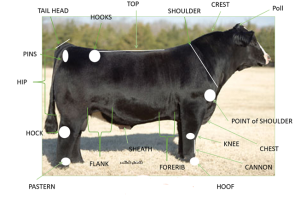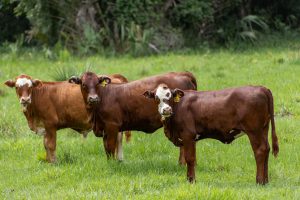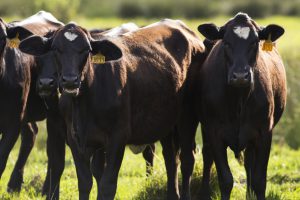Depending on which calving season you have, cattlemen must make decisions on which heifer calves they want to keep or buy for their herd. Usually, 10-20% of your herd will need to be replaced with heifers each year. It is extremely important to apply adequate selection pressure to prospective herd replacements at weaning and after weaning. Developing these heifers to become productive females in your cow herd can be a tremendous investment in a cow-calf operation. The following are some guidelines that should be used when selecting your replacement heifers.
Record Keeping
- An individual record should be kept on each cow in your herd.
- Calving time, birth weight, and calf growth is the essential information.
- Keeping information on Calving Percentage, Cow Performance, Weaning Weights, and Quality of Calves at Weaning will help with selecting high-quality heifers.
Longevity is Important
- Keeping heifers that are being selected from the cows that are producing a heavy weight and high-quality calf consistently is important.

Beef cattle in a pasture. Photo taken 06-25-21 - Keep notes on birth dates and select heifers that were born at the beginning of your calving season.
- Select high-quality heifers at weaning time, Heifers from a High Milking Dam, Disposition, Visual Appraisal, and Adequate Growth
Heifer Average Daily Gain
- Heifers should gain 1.5-2.25 lbs a day to reach 65% of their mature weight.
- They should be bred around 15 months so they can calve at 2 years old.
- Monitor your heifers by viewing their body condition scores to ensure they’re gaining the right amount of weight. Weight may vary on the breed of the heifer.
- Mature weight:1200 lbs
- Weight at breeding:780 lbs
Conditioning
- Make sure your heifers are achieving an ideal average daily weight gain to avoid over and under conditioning.
- Tips on how to overcome these challenges
- High enough protein concentration to support muscle growth.
- Ideal heifer development in crude protein percentage in their diet 13-14% and TDN of 55%.

2015 Range Cattle Research and Education Center Field Day in Ona, Florida on Thursday, April 9th.
- Make sure energy content is enough to reach the target ADG.
- Another option: Winter annual grasses such as oats, triticale, Rye pr a combination of those.
- Make a plan and have a good backup plan if forage production is not optimal
Reproduction Potential
- Keep a record of who has come into heat and who hasn’t when your heifers have reached breeding age.
- If your heifers aren’t cycling, you can set them up with an estrus synchronization protocol to get them to reach puberty
- Different ways to document if your heifers are ready for the breeding season:
- Take record to see who has come into standing heat
- Use the Reproductive Tract Score method by a large animal practitioner with palpation and/or ultrasound technology
- Obtain pelvic measurements 2-3 weeks before breeding season
- Palpating for ovarian development
Selection Based on Visual Appraisal
When selecting heifers visually, the following criteria should be considered:
Volume & Capacity
- Spring of rib
- Depth of body
- Natural thickness & shape down the top
- Width & depth to stifle
- Width in her pin set
Frame & Growth
- Moderate frame
- Length of body
- High performance

Design & Structure
- Stands square on front & rear legs
- Heavy boned
- Walks with flexibility in their pasterns
- Level from her hooks to her pins
- Moves with flexibility in her hock
- Correct angle in her shoulder
Femininity
- Feminine: Want your females to look like females
- Smooth shoulder
- Long fronted
- Check her teats and make sure they look uniformed
Balance
- Level down her top
- Want her forerib to be level with her flank
- Deep flank
 1
1


